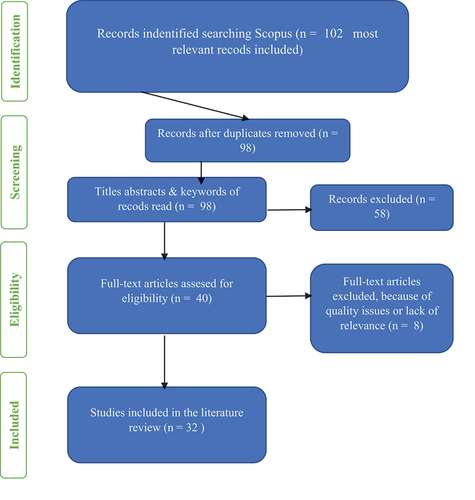Abstract
This systematic literature review study aims to identify, review, and study the trend of scientific publications on urban farming in realizing the resilience of developing cities in Indonesia. The urban farming trend in Indonesia is a response to overcoming the problem of food security in urban areas as well as a solution to boosting the economy during the crisis due to COVID-19 and creating urban resilience. It will also explore the issue of urban farming as a supplier of projected food availability and food security in urban areas in Indonesia. This research provides scientific guidelines and recommendations for developing urban agriculture studies in Indonesia. This research can be used as scientific data and policy notes on the problem of urban farming in Indonesia. The findings of this study suggest that urban farming will help promote urban resilience in Indonesia, especially given the problems of production, food security, and land scarcity in urban areas. Urban farming in Indonesia’s urban resilience design has several weaknesses even though it has positive effects.
1. Introduction
Every human being, even every living thing, must have basic needs, including the need for food (Vinayak, Citation2022). Various ways for humans to be able to meet their food needs either directly or indirectly (Trivellone et al., Citation2022). Humans can directly grow crops, raise livestock and catch fish and other marine products (Willer et al., Citation2022). Indirectly, by seeking access to food needs such as the market for agricultural products (in general) to meet these basic needs (Trivellone et al., Citation2022; Willer et al., Citation2022). Such importance of food to man is recognized by the state that food affairs are mandatory affairs so that creatures can continue to live. A country’s food security will be one of the indicators of the sovereignty of the country itself (Elfida, 20 20; Sastraatmadja, Citation2022; Trivellone et al., Citation2022; Willer et al., Citation2022).
Currently, urban resilience is a concern in many parts of the world, where urban resilience is defined as the endurance of urban ecosystems in facing threats and disturbances on social, economic, and ecological dimensions in the future (Prianto & Abdillah, Citation2023; Widianingsih et al., Citation2023). According to Langemeyer et al. (Citation2021) and Gulyas and Edmondson (Citation2021) said that one of the problems of vulnerability in urban areas is how food security meets food needs in urban areas. This is an urban challenge to meet food adequacy to support urban resilience through urban farming (Gulyas & Edmondson, Citation2021; Langemeyer et al., Citation2021). Various studies have shown that the influence of urban farming can be a way to create urban resilience in facing future vulnerabilities and threats (Ferreira et al., Citation2018; Grochulska-Salak et al., Citation2021; Gulyas & Edmondson, Citation2021; Langemeyer et al., Citation2021). Nur, K. W. (202) said In Makassar City, Indonesia revitalized urban alleys to encourage the implementation of urban farming in the Makassar spatial plan as urban land use and positive urban reciprocal interaction. In research by Suparwoko and Taufani (Citation2017) also to face the threat of food security in Indonesia’s big cities with rapid physical development and a lack of green land, the government is pushing for the implementation of urban farming. This is why this research is important in understanding practical and theoretical developments regarding urban farming in Indonesia.
The essence of realizing urban resilience is one of the best steps, namely starting with realizing food security itself first (Liu et al., Citation2022; Yan et al., Citation2022). To realize urban life, first of all, ensure that the people in it live properly with sufficient food available (Russo & Escobedo, Citation2022). The phenomena make the development of food security in Indonesia, more it gets noticed day by day. This attention was realized by the Indonesian government by issuing Government Regulation (PP) no. 68 of 2002 concerning Food Security, Food Security is a condition for the fulfillment of food for households which is reflected in the availability of sufficient food, both in quantity and quality, safe, equitable, and affordable. In addition, there is Presidential Regulation No. 66 of 2021 concerning the National Food Agency. After nine years of waiting for the end of the mandate of Law No. 18 of 2012 concerning Food, which requests that the Government establish food institutions at the national level (Elfida, Citation2020; Newman et al., Citation2022; Sastraatmadja, Citation2022). Recognizing the lack of food security in Indonesia, based on the national policy on food security, efforts have been made to develop urban agriculture in various regions in Indonesia.
Various urban farming programs in various regions of Indonesia are intended to realize food security and support economic growth in Indonesia to create urban resilience to face future vulnerabilities (Qurani et al., Citation2020; Aditya and Zakiah, Citation2022; Elfida, Citation2020; Ferdaus, Citation2022; Kementan, Citation2022; Malik et al., Citation2021; Sastraatmadja, Citation2022; Atmaja et al., Citation2020). This urban farming developed in response to the many problems related to urban life. Namely, the decreasing agricultural land due to development, the increase in food demand in urban areas, environmental pollution due to pollutants, and the economic crisis due to COVID-19 (Kementan, Citation2022; Ferdaus, Citation2022; Wibowo et al., Citation2021; Silitonga et al., Citation2022; Suantika, Citation2018; Wunarlan et al., Citation2023). This triggers people with the ability and knowledge in agriculture to take advantage of opportunities by optimizing the potential of surrounding resources. The goal is to cultivate vegetable crops on limited and abandoned land optimally as Urban Farming (Elfida, Citation2020; Ferdaus, Citation2022; Kementan, Citation2022; Sastraatmadja, Citation2022).
The urban farming trend, if it continues to be developed and is projected to be a supplier for food availability and food security in urban areas (Darmawan et al., Citation2023; Elfida, Citation2020; Ferdaus, Citation2022; Kementan, Citation2022; Sastraatmadja, Citation2022). The ability to meet food needs independently will reduce the obstacles to food distribution in urban areas (Hardiana and Hutasuhut, Citation2021; Gusfarina et al., Citation2021; Elfida, Citation2020; Ferdaus, Citation2022; Kementan, Citation2022; Sastraatmadja, Citation2022). As a lifestyle, the urban farming trend is considered a healthy lifestyle. This is because most urban farms prefer to implement an organic planting system that does not use chemical fertilizers and synthetic pesticides. Urban farming can create a comfortable and healthy environment to live in with various planting systems such as viticulture, hydroponics, and aquaponics that can easily be applied in limited areas (Prayoga et al., Citation2020; Novira et al., Citation2019; Elfida, Citation2020; Ferdaus, Citation2022; Kementan, Citation2022; Sastraatmadja, Citation2022). This research is intended to look at these trends, identify developing issues, as well as look at the relationship between studies and problems regarding urban farming in Indonesia.
2. Objectives
This study aims to investigate the trend of urban farming in Indonesia in terms of current data sharing and factors related to it in terms of journals published in the Scopus database. The analysis is based on data from 106 documents with the keywords “Urban Farming” and “Indonesia” in the Scopus Database. Research questions include: To what extent are the trends in scientific publications studying urban farming in Indonesia? who are the researchers contributing to scientific publications on the topic? what are the latest research issues/topics related to the issue of Urban Farming in Indonesia? And an assessment based on 32 articles on this topic reveals much exploratory, conceptual, qualitative, and practice-driven research in studies reflecting the increasing complexities of urban farming—urban resilience and the resulting implications, opportunities, and risks thereof for urban resilience.
3. Methods
3.1. Ethics statement
Neither approval by the institutional review board nor obtainment of the informed consent was required since this was a literature-based study.
4. Study design
This was a descriptive study based on journals’ policies. This study uses the systematic literature review analysis method with data sources from literature studies from various scientific journals. The primary data used in this research was taken from the Scopus database. The author chose the Scopus database because it has complete data and is also one of the databases with the highest rating in various scientific fields. And they are also equipped with various literature studies to improve research accuracy and get the best conclusions. To produce relevant discussions and conclusions, the authors use the VOSiewer analysis tool version 1.6.17 as a suitable data processing tool (tools for identification and analysis) from the Scopus Database (Abdillah et al., Citation2022; Bano & Zowghi, Citation2015; Batini et al., Citation2009). Other analysis tools also use “analyze search results” on scopus.com.
5. Data collection methods
A total of 102 documents accessed in 1 January 2023 include urban farming in Indonesia, a total of 40 documents mapped and analyzed following the trend of research publication data search results in Scopus. Any data or goods displayed based on search results, and filtered through scopus.com (in the “analyze search results” feature), are then identified and analyzed using the VOSviewer version 1.6.17 feature to be visualization (Abdillah et al., Citation2022; Van Eck & Waltman, Citation2010). The visualized data follows the calculated weights and also looks at the trends of the existing data based on the data obtained. It also influenced the study not to display data visualizations on other less relevant items. Results from identification and exploration based on 3 criteria relevant si with the topic of Urban Farming in Indonesia which refers to (1) Suitability with the research topic; (2) Connectedness to the topic of research; and (3) Research implications found or recommended (Bano & Zowghi, Citation2015; Batini et al., Citation2009).
At this stage, each abstract is checked independently by at least two authors. Minor differences of opinion were discussed and resolved in meetings where the agreement was reached. According to the above criteria, 8 studies were deleted, and 98 studies remained retrieved from 2004–2022. Second, the relevance and quality of the 98 studies were assessed by reading the full articles. Then 40 studies were feasibility-reviewed and independently assessed according to independent-dimensional quality criteria from Batini et al. (Citation2009) and Bano and Zowghi (Citation2015), with several criteria:
Accuracy: research objectives are clearly stated, and data collection methods are adequately explained. References support important statements in the paper.
Consistency: research design according to research objectives. Research questions answered or research objectives achieved.
Completeness: the study’s research approach is explained in sufficient detail.
Timeliness: this study was published between 2004-2022.
This led to the final selection of 32 research studies from 2004–2022 that directly address the question of the development of urban farming in Indonesia (see Figure ). In accordance with our inclusion and exclusion criteria, the limited number of studies remaining, despite our extensive search of the relevant literature, is a finding in itself. This small number highlights the dearth of research examining the topic of urban farming in urban resilience strategies in Indonesia.
6. Data analysis
Data analysis of this study through keywords “(TITLE-ABS-KEY (urban and farming) AND TITLE-ABS-KEY (INDONESIA)) AND (LIMIT-TO (PUBYEAR, 2023) OR LIMIT-TO (PUBYEAR, 2022) OR LIMIT-TO (PUBYEAR, 2021) OR LIMIT-TO (PUBYEAR, 2020) OR LIMIT-TO (PUBYEAR, 2019) OR LIMIT-TO (PUBYEAR, 2018) OR LIMIT-TO (PUBYEAR, 2016) OR LIMIT-TO (PUBYEAR, 2017) OR LIMIT-TO (PUBYEAR, 2016) OR LIMIT-TO (PUBYEAR, 2015) OR LIMIT-TO (PUBYEAR, 2013) OR LIMIT-TO (PUBYEAR, 2013) OR LIMIT-TO (PUBYEAR, 2012) OR LIMIT-TO (PUBYEAR, 2011) OR LIMIT-TO (PUBYEAR, 2009) OR LIMIT-TO (PUBYEAR, 2008) OR LIMIT-TO (PUBYEAR, 2007) OR LIMIT-TO (PUBYEAR, 2006) OR LIMIT-TO (PUBYEAR, 2004))” that is in the Scopus Database. All search result data is stored in a CSV (Excel) file which is then processed and checked using the VOSiewer program version 1.6.17. VOSviewer is a tool for displaying and analyzing trends in systematic literature review maps (Van Eck & Waltman, Citation2010). The program can display and depict bibliometric visual maps with unique data through identification and analysis of the types of analysis that can be visualized in Vosviewer, as Figure follows:
Figure 2. Systematic Literature Review analysis is assisted by the Vosviewer tool. Source: Processed from various sources, 2023.

This systematic literature review analysis approach is used to help provide a data set that can be utilized by policy-makers, academics, and other stakeholders to improve the quality of future research (Abdillah et al., Citation2022; DiVaio et al., Citation2022; Wang et al., Citation2021). The systematic literature review method is also a comprehensive and reliable way of reviewing and evaluating scientific publications to understand the development of certain research topics (Moral-Muñoz et al., Citation2020; Wagner et al., Citation2011). The analysis of this research is also to see how the influence of urban combat can be a way to create muscle resilience in facing future vulnerabilities and threats.
7. Results – systematic literature review
7.1. Mapping of research topics: An overview
In mapping research topics and reviewing in this study, as early as 102 documents were identified and analyzed through the links scopus.com (Analyze search results) and Vosviewer (Van Eck & Waltman, Citation2010) to find out and see trends in research publications on the topic of urban farming in Indonesia in the Scopus database. The results show a trend of increasing each year even though the increase is still dynamic. This increase was influenced by developing issues such as urban food scarcity, expansion of urban land and arrangement of agricultural land, natural disasters, environmental issues, and so on. This trend can be seen in Figure below:
Figure 3. Trends Document publication on Urban Farming in Indonesia (2004–2022). Source: Processed through Scopus, 2023.
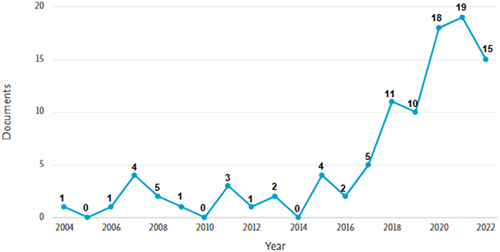
The tendency to increase the number of publications comes from collaborative studies of various countries in the world in studying urban farming and urban resilience in Indonesia. The trend of increasing every year is influenced by several things such as the interest of researchers regarding urban farming and urban resilience in Indonesia, research funding support, and access to available research data. Then 2021 is the year with the highest number of publications in the last ten years in the Scopus database.
In Figure there are the top 10 countries of origin of various authors who study and publish several scientific documents regarding the study of urban farming in Indonesia, such as (1) Indonesia with 33 documents (173 citations); (2) Netherlands with 3 documents (28 citations); (3) Japan with 3 documents (49 citations); (4) Germany with 2 documents (2 citations); (5) United States with 2 documents (2 citations); (6) France with 1 document (4 citations); (7) China with 1 document (10 citations); (8) Malaysia with 1 document (34 citations); (9) Singapore with 1 document (13 citations); and (10) Taiwan with 1 number of documents (0 citations). It can be concluded that the author’s country of origin is Indonesia with 32 documents, followed by the Netherlands and Japan with 3 documents each. This indicates that the topic of Urban Farming which supports urban resilience in Indonesia has been studied by various countries around the world. This was because (1) various researchers in Indonesia and the Netherlands wanted to understand the relationship between urban farming and urban socio-economic systems; (2) several researchers in Japan also understand the ecological landscape and urban biodiversity in Indonesia’s tropical cities; (3) not much different from researchers from Singapore who wish to understand the relationship between urban farming, food security, and development policies in Indonesia. And (4) the issue of environmental pollution and poverty reduction is another reason for researchers from various countries in the world to be interested in studying urban farming and urban resilience in Indonesia.
Figure 4. Top 10 Country with the highest number of documents and Citations in the Scopus Database Regarding Urban Farming in Indonesia (Analyze Type: Co-Authorship (Country)). Source: Processed via Vosviewer, 2023.
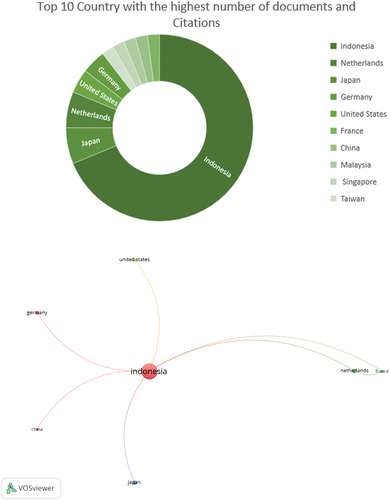
In addition to the country of origin of the author who studies and publishes various scientific documents regarding the issue of Urban Farming in Indonesia. In Figure , the published study document has various types of documents, such as (1) Articles with a total of 57 documents; (2) Conference Paper with 32 documents; (3) Revision Conference with 5 documents; (4) Review with 5 documents; (5) Book Chapter with 1 document; (6) Erratum with 1 document; and (6) Short Survey with 1 document. It can be concluded that the variety of types of documents regarding urban farming studies in Indonesia makes this issue one of the concerns for researchers in the world, this is shown by 6 types of published documents discussing urban farming in Indonesia in the Scopus database.
Figure 5. The Type of Document with the Most Publications About Urban Farming in Indonesia. Source: Processed through Scopus, 2023.
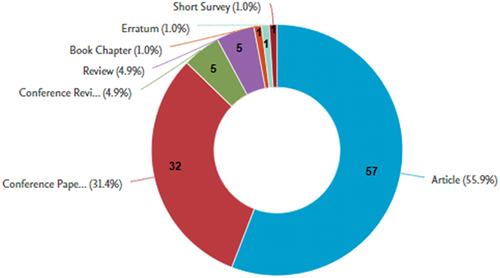
Various types of documents were published in the Scopus database regarding urban farming in Indonesia. Figure shows that various subject areas are closely related to urban farming in Indonesia, such as (1) Environmental Science with 53 documents; (2) Social Sciences with 33 documents; (3) Agricultural and Biological Sciences with 26 documents; (4) Earth and Planetary Science with 26 documents; (5) Engineering with 15 documents; (6) Energy with 13 documents; (7) Computer Science with 11 documents; (8) Economics, Econometrics, and Finance with 5 documents; (9) Medicine with 5 documents; and (10) Physics and Astronomy with 4 documents. Of the various subject areas, these are the top 10 subject areas with the most number of documents. This indicates that the issue of urban farming studies in Indonesia is studied through various perspectives, approaches, and variants of scientific disciplines. So that to be able to understand the study of urban farming issues cannot only be seen as environmental problems, social problems, energy problems, economic and health problems but needs to be studied from various sciences so that the problems that exist in urban farming in Indonesia can be overcome.
Figure 6. Subject Area of the Most Publications Regarding Urban Farming in Indonesia. Source: Processed through Scopus, 2023.
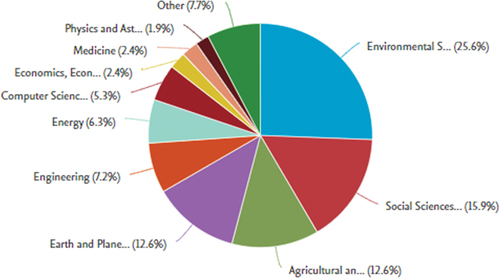
Figure shows the Top 10 Authors with the highest number of document ideas discussing Urban Farming in Indonesia, namely: (1) Personal, Pribadi and Pauleit (Citation2016) with 59; (2) Arifin and Nakagoshi (Citation2011) with 49 citations; (3) Devendra C. (Citation2007) with 34 citations; (4) Suantika et al. (Citation2018) with 25 citations; (5) Abdoellah, O.S. (Citation2020) with 22 citations; (6) Surya et al. (Citation2020) with 20 citations; (7) Suparwoko, S. and Taufani, B. (Citation2017) with 15 citations; (8) Chandra and Diehl (Citation2019) with 13 citations; (9) Putra, A. S. (Citation2020) with 10 citations; and (10) Wibowo et al. (Citation2021) with 7 citations. It can be concluded that the document on the topic of urban farming in Indonesia is a reference and study studied in various parts of the world. And the most referenced documents come from documents published by Indonesian authors. A publication document that affects other published documents can be seen in the number of citations, the more citations of a document, the greater the influence will be on the research topic under study.
Figure 7. Top 10 Authors with the highest number of Citations in the Scopus Database regarding Urban Farming in Indonesia (Analyze Type: Co-Citation (Document)). Source: Processed via Vosviewer, 2023.
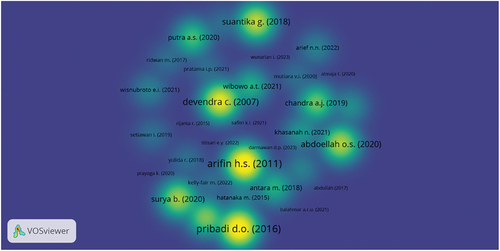
The systematic literature review in this study shows that research on the problem of Urban Farming in Indonesia is an urban agricultural problem that continues to be developed and is projected to be a supplier for the availability of foodstuffs and food security in urban areas in Indonesia. Trends regarding this study have been seen since 2004 continuing to increase until 2022 which is published in the database Scopus. The issue about the study of urban farming in Indonesia has been studied through various perspectives, approaches, and variants of scientific disciplines. And there are various types of documents documenting urban farming studies in Indonesia published in the Scopus database (at least 6 subject areas have been identified). The top 10 authors who published their documents were: (1) Pribadi and Pauleit (Citation2016) with 59; (2) Arifin and Nakagoshi (Citation2011) with 49 citations; (3) Devendra C. (2007) with 34 citations; (4) Suantika et al. (Citation2018) with 25 citations; (5) Abdoellah, O.S. (2020) with 22 citations; (6) Surya et al. (Citation2020) with 20 citations; (7) Suparwoko (2017) with 15 citations; (8) Chandra and Diehl (Citation2019) with 13 citations; (9) Haase Putra, U.S. (2020) with 10 citations; and (10) Wibowo et al. (Citation2021) with 7 citations.
8. Mapping of research topics: Content analysis & issues
Below are identified various research topics that are closely related to Urban Farming in Indonesia based on various documents that have been published in the Scopus Database. It was found that the research issues related to this research topic are shown in Figure (explain the grouping of research issues that are most related to one another):
Figure 8. Analysis via Vosviewer (Analyze Type: Co-occurrence (All Keywords)). Source: Processed via Vosviewer, 2023.
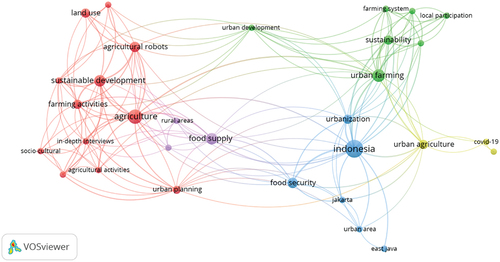
In the review through Vosviewer in Figure as many as 32 research documents were derived from the Scopus database. The results found that five (5) clusters have become a trend ds research topic on urban farming which until now has become the focus of global researchers and has become a serious study in Indonesia. The 5 clusters are divided into, The first cluster (red), Its tendency focuses on ISS Agricultural Activities, Agricultural Robots, Farming Activities, Land Use, Population Statistics, Sustainable Development, Urban Environments, and Urban Planning; The second cluster (green), is more likely to learn about farming systems, local participation, study the phenomenon of agricultural problems in South Sulawesi, urban farming, and urban development; The third cluster (blue), is more likely to study the problems regarding food security in East Java, Jakarta, and Food Security in urban areas due to urbanization; The fourth cluster (yellow), is more likely to learn about urban agricultural problems during the COVID-19 pandemic; and The fifth cluster (purple), is more likely to learn about the agricultural sector about the supply of food and food in rural areas. In each cluster is the main issue of research on urban farming that has been widely studied and published in the Scopus database. The research topic can build future researchers in developing topics regarding urban farming problems in Indonesia. So that this research contributes practically and theoretically to developing a diversity of literature on the problem of urban farming in Indonesia. This research issue, can also be research data looking at global research trends regarding what has been, has not been, and will be studied further on the topic of urban farming in Indonesia.
Not much different from what is shown in Figure above (explain the novelty of the research topic). The results of the visualization (Overlay Visualization) show that there are several trends in the latest research (shown in the picture with the brightest color “yellow”) from 2018 until 2020 which are a serious concern studied by global researchers regarding the issue of urban farming and urban resilience in Indonesia. Some of the research issues are: (1) The discussion of urban farming in relation to urban resilience in Indonesia is a study that is still hotly discussed; (2) Urban farming as a phenomenon that is still being studied recently in the issue of urban resilience in Indonesia; (2) Excessive land use is the cause of urban farming in realizing urban food security; (3) Local participation in the topic new of urban farming activities that are still being studied; and (4) Urban farming before and after the COVID-19 pandemic as an issue new that is still being studied.
Figure 9. Analysis via Vosviewer (Analyze Type: Co-occurrence (All Keywords)). Source: Processed via Vosviewer, 2023.
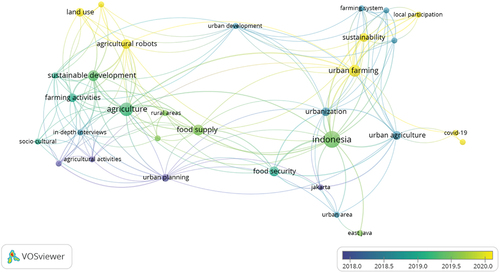
Several research trend issues explored regarding urban farming in realizing urban resilience in Indonesia, it is still lacking and there is still little research on the study about that. The results of this identification and analysis are intended to support existing studies and encourage studies on urban farming in realizing urban resilience in Indonesia and in various countries around the world. The researcher concludes that Indonesian researchers can develop the issue of urban farming research in realizing urban resilience based on these four important issues.
9. Discussion –research identification
9.1. Implications of urban farming in supporting urban resilience in Indonesia: A challenge and opportunity for Indonesia
In this section, we discuss the implications of Urban Farming in supporting urban resilience in Indonesia, as identified from the articles in our sample. We identify challenges that we categorize into 4 categories: (1) Urban Farming as a Strength in Urban Resilience, (2) Weaknesses of Urban Farming in Urban Resilience, (3) Threats from Urban Farming in Urban Resilience in Indonesia and (4) Urban Farming as an Opportunity in Urban Resilience in Indonesia (see Table ).
Table 1. Result of Identification Research is based on the suitability, relevance, and similarity of this research topic (the selection is based on the document citation level in Scopus)
In this study, the trend of previous research (in a systematic literature review that we have made) regarding Urban Farming towards Urban Resilience has several opportunities based on relevant studies that have been published. The researchers divided it into 4 categories, namely: (1) This tendency can be seen in the lack of (potential) Urban Farming in encouraging urban resilience in Indonesia through suburban farming and individual farmers in urban communities in Metropolitan Areas in Indonesia (Ridwan et al., Citation2017; Adiprasetyo et al., Citation2015; Pribadi & Pauleit, Citation2016), policy support (Arifin & Nakagoshi, Citation2011), Urban Farming as a solution to the vulnerability of urban communities in Indonesia (Nur, Citation2020; Surya et al., Citation2020), Urban Farming as an agricultural solution facing the problem of limited land in urban areas in Indonesia (Rijanta, Citation2015; Chandra & Diehl, Citation2019; Taufani & Taufani, Citation2017); (2) Weaknesses in Urban Farming to realize Urban Resilience in Indonesia, such as urbanization & dense population making it difficult to use the land for urban farming, the thing that most affects food security in Indonesia is land ownership for farmers (Mutiara et al., Citation2020; Wisnubroto et al., Citation2021), much land is controlled by the private sector (Pratama et al., Citation2021); (3) Threats faced by Urban Farming towards Urban Resilience, such as the problem of plastic waste (Wibowo et al., Citation2021; Yossyafra et al., Citation2018), and the dilemma of young farmers in urban farming (Safitri et al., Citation2021; Safitri et al., Citation2022; Setiawan et al., Citation2019); and (4) Opportunities in encouraging urban resilience through Urban Farming in Indonesia, developing a Hybrid Zero Water Discharge (ZWD) to improve water quality in boosting productivity in Urban Farming (Suantika et al., Citation2018; Ulfa et al., Citation2022), there is an intensification of the dominant cultivation strategy implemented by farmers in urban farming in Indonesia (Titisari et al., Citation2022; Hatanaka, Citation2015; Syaifudin & Carsjens, Citation2018), the role of female farmers in Urban Farming (Yulida et al., Citation2018). Some of these studies represent research identification tendencies that have been published in studying the issue of Urban Farming for Urban Resilience in Indonesia.
According to the research’s conclusions, urban farming will help Indonesia’s cities become more resilient, particularly in light of issues with production, food security, and urban land scarcity. Urban farming in Indonesia’s urban resilience design has several drawbacks despite its positive effects. Accordingly, this study suggests that the Indonesian government create a green policy that focuses on the growth of urban farming in a variety of Indonesian regions. In order to address the community’s economic vulnerability, which has an impact on the region’s urban resilience, the policy must be flexible and in line with the demands and circumstances of urban regions.
10. Conclusion
Trends related to this study have been recorded since 2004 and continue to increase until 2022, 32 documents that match the topics studied in this study are obtained, according to a publication in the database Scopus. The topic of urban farming and urban resilience in Indonesia has been studied from various perspectives, methodologies, and scientific disciplines. Various types of research papers on urban farming in Indonesia have been published in the Scopus database (at least 6 fields of study have been identified). The top 10 authors who published their document are (1) Pribadi and Pauleit (Citation2016) with 59 citations; (2) Arifin and Nakagoshi (Citation2011) with 49 citations; (3) Devendra C. (2007) with 34 citations; (4) Suantika et al. (Citation2018) with 25 citations; (5) Abdoellah, O.S. (2020) with 22 citations; (6) Surya et al. (Citation2020) with 20 Citations; (7) Suparwoko (2017) with 15 citations; (8) Chandra and Diehl (Citation2019) with 13 citations; (9) Haase Putra, A.S. (2020) with 10 citations; and (10) Wibowo et al. (Citation2021) with 7 citations. Then there are several countries that are interested in learning about urban farming in realizing urban resilience in Indonesia, such as (1) the Netherlands; (2) Japan; (3) Singapore); (4) Germany, and many more.
Research topics on urban farming in Indonesia can help future researchers in understanding the problems of urban farming in Indonesia. So that this research contributes practically and theoretically to developing a diversity of literature on the problem of urban farming in Indonesia. This research issue can also be research data looking at the trend of global research is what has been, has not been, and will be studied further on the topic of urban farming in Indonesia. The researcher recommends that future researchers focus on: (1) How is the best model of urban farming in realizing urban resilience; (2) How to develop urban resilience in urban farming; (2) How is the use of limited land for urban farming; (3) how to promote urban farming to increase local participation in urban farming activities; and (4) what is the post-pandemic impact of COVID-19 on urban food security.
The implication of this research is that urban farming will help in encouraging urban resilience in Indonesia, especially in the problems of production and food security, to the problem of limited land in urban areas. Even though it has a good impact, Urban Farming in designing urban resilience in Indonesia still has limitations. So based on this, this research recommends the Indonesian government formulate a green policy that focuses on the development of Urban Farming in various regions in Indonesia. These policies must be adaptive and in accordance with the needs and conditions of urban areas in facing the economic vulnerabilities of the community which have an impact on urban resilience in these areas.
Author contributions
“Conceptualization, A.A. and I.W.; methodology, A.A.; software, A.A.; validation, I.W., A.B. and H.N.; formal analysis, A.A.; investigation, I.W.; resources, A.A.; data curation, A.A.; writing—original draft preparation, A.A.; writing—review and editing, I.W.; visualization, A.A.; supervision, I.W., A.B. and H.N; project administration, I.W., A.B. and H.N; funding acquisition, I.W., A.B. and H.N. All authors have read and agreed to the published version of the manuscript.
Acknowledgments
Thanks to the Faculty of Social & Political Sciences, Padjadjaran University for supporting this research, so that this research can be completed and published.
Disclosure statement
No potential conflict of interest was reported by the authors.
Data availability statement
The results of the study can be found in the figures attached in the article. The data set used to support the findings of this study is available from the corresponding author upon request.
Additional information
Funding
Notes on contributors
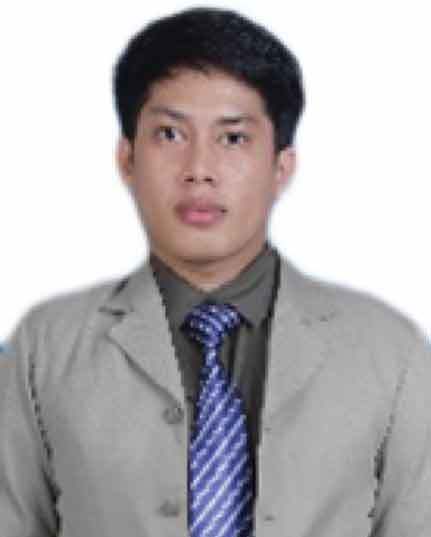
Ida Widianingsih
Abdillah Abdillah is Doctoral Student and Assistant Professor in the Administrative Sciences Program, Faculty of Social and Political Sciences, Universitas Padjadjaran, Bandung, Indonesia. His research interests relate to Local Government Studies, Climate Change Governance, Urban Resilience, Artificial Intelligence in Government, and Local political. Email: [email protected]
Ida Widianingsih is a Professor at Public Administration Department and Vice Dean for Learning, Student, and Research Affairs of the Faculty of Social and Political Sciences, Universitas Padjadjaran, Indonesia. Her research interests relate to public administration and development issues, inclusive development policy, and participatory governance. Email: [email protected]
Rd Ahmad Buchari
Rd Ahmad Buchari is a lecturer at the Public Administration Department, Faculty of Social and Political Sciences, Padjadjaran University, Indonesia. His research relates to Local Government, Public Policy Leadership, and Disaster Management. Email: [email protected]
Heru Nurasa
Heru Nurasa is a lecturer at the Department of Public Administration, Faculty of Social and Political Sciences, Padjadjaran University, Indonesia. His research is related to Dynamic Systems, Public Organizations, and Public Management. Email: [email protected]
References
- Abdillah, A., Widianingsih, I., Buchari, R. A., Mustari, N., & Saleh, S. (2022). Governance and Quintuple Helix innovation model: Insights from the local government of East Luwu Regency, Indonesia. Frontiers in Climate, 4(1012108). https://doi.org/10.3389/fclim.2022.1012108
- Abdoellah, O. S., Schneider, M., Nugraha, L. M., Suparman, Y., Voletta, C. T., Withaningsih, S., & Hakim, L. (2020). Homegarden commercialization: Extent, household characteristics, and effect on food security and food sovereignty in Rural Indonesia. Sustainability Science, 15, 797–21. https://doi.org/10.1007/s11625-020-00788-9
- Adiprasetyo, T., Sukisno, S., Setyowati, N., Ginting, S., & Handajaningsih, M. (2015). The prospect of horticultural organic farming as sustainable agricultural practice for reducing poverty: The case in Bengkulu City, Indonesia. International Journal on Advanced Science, Engineering and Information Technology, 5(6), 402–406. https://doi.org/10.18517/ijaseit.5.6.595
- Aditya, R. B., & Zakiah, A. (2022). Practical reflection and benefits of making a food garden at home during Covid-19 pandemic. International Journal of Food Studies, 11(1), 85–97. https://doi.org/10.7455/ijfs/11.1.2022.a8
- Arifin, H. S., & Nakagoshi, N. (2011). Landscape ecology and urban biodiversity in tropical Indonesian cities. Landscape & Ecological Engineering, 7(1), 33–43. https://doi.org/10.1007/s11355-010-0145-9
- Atmaja, T., Yanagihara, M., & Fukushi, K. (2020). Geospatial Valuation of Urban Farming in Improving Cities Resilience: A Case of Malang City, Indonesia. The International Archives of Photogrammetry, Remote Sensing & Spatial Information Sciences, 43, 107–113. https://doi.org/10.5194/isprs-archives-XLIII-B5-2020-107-2020
- Bano, M., & Zowghi, D. (2015). A systematic review on the relationship between user involvement and system success. Information and Software Technology, 58, 148–169. https://doi.org/10.1016/j.infsof.2014.06.011
- Batini, C., Cappiello, C., Francalanci, C., & Maurino, A. (2009). Methodologies for data quality assessment and improvement. ACM Computing Surveys, 41(3), 1–52. https://doi.org/10.1145/1541880.1541883
- Chandra, A. J., & Diehl, J. A. (2019). Urban agriculture, food security, and development policies in Jakarta: A case study of farming communities at Kalideres–Cengkareng district, West Jakarta. Land Use Policy, 89, 104211. https://doi.org/10.1016/j.landusepol.2019.104211
- Darmawan, D. P., Arisena, G. M. K., Djelantik, A. A. A. W. S., Krisnandika, A. A. K., Utari, N. K. S., & Korri, N. T. L. (2023). Farmers’ Independence Level in the Urban Area of Subak Sembung Denpasar City, Bali Province, Indonesia. Journal of Agricultural Sciences – Sri Lanka, 18(1), 40. https://doi.org/10.4038/jas.v18i1.10097
- Devendra, C. (2007). Perspectives on animal production systems in Asia. Livestock Science, 106(1), 1–18. https://doi.org/10.1016/j.livsci.2006.05.005
- DiVaio, A., Hassan, R., & Alavoine, C. (2022). Data intelligence and analytics: A bibliometric analysis of human–Artificial intelligence in public sector decision-making effectiveness. Technological Forecasting & Social Change, 174, 121201. https://doi.org/10.1016/j.techfore.2021.121201
- Elfida. (2020). Urban Farming: Solusi Ketahanan Pangan Rumah Tangga Perkotaan. [ online] available at accessed on January 2023 https://babelprov.go.id/artikel_detil/urban-farming-solusi-ketahanan-pangan-rumah-tangga-perkotaan
- Ferdaus, S. A. (2022). Urban Farming Solusi Pertanian dengan Minim Lahan. [ online] available at accessed January 2023 https://umsida.ac.id/urban-farming-solusi-pertanian-dengan-minim-lahan/
- Ferreira, A. J. D., Guilherme, R. I. M. M., Ferreira, C. S. S., & Oliveira, M. D. F. M. L. D. (2018). Urban agriculture, a tool towards more resilient urban communities? Current Opinion in Environmental Science & Health, 5, 93–97. https://doi.org/10.1016/j.coesh.2018.06.004
- Grochulska-Salak, M., Nowysz, A., & Tofiluk, A. (2021). Sustainable Urban Agriculture as Functional Hybrid Unit—Issues of Urban Resilience. Buildings, 11(10), 462. https://doi.org/10.3390/buildings11100462
- Gulyas, B. Z., & Edmondson, J. L. (2021). Increasing city resilience through urban agriculture: Challenges and solutions in the Global North. Sustainability, 13(3), 1465. https://doi.org/10.3390/su13031465
- Gusfarina, D. S., Widada, A. W., & Nurhayati, A. (2021 October). Contribution of home-garden farming to household income and its sustainability in Yogyakarta City, Indonesia In IOP Conference Series: Earth and Environmental Science(Vol. 883, no. 1, p. 012035). IOP Publishing. https://doi.org/10.1088/1755-1315/883/1/012035
- Hardiana, M. I., & Hutasuhut, D. A. S. (2021 February). The role of agroedu-tourism program in enhancing young generation’s knowledge on urban farming: Hydroponics technique In Journal of Physics: Conference Series(Vol. 1796, no. 1, p. 012088). IOP Publishing. https://doi.org/10.1088/1742-6596/1796/1/012088
- Hatanaka, M. (2015). Organic certification and the rationalization of alternative food and agriculture: Sustainable shrimp farming in Indonesia. Re-thinking organic food and farming in a changing world. https://doi.org/10.1007/978-94-017-9190-8_3
- Kementan. (2022). Urban Farming Dukung Pertumbuhan Ekonomi Indonesia. [online] available at accessed January 2023 https://www.pertanian.go.id/home/?show=news&act=view&id=4691
- Langemeyer, J., Madrid-Lopez, C., Beltran, A. M., & Mendez, G. V. (2021). Urban agriculture—A necessary pathway towards urban resilience and global sustainability? Landscape and Urban Planning, 210, 104055. https://doi.org/10.1016/j.landurbplan.2021.104055
- Liu, Y., Li, Q., Li, W., Zhang, Y., & Pei, X. (2022). Progress in urban resilience research and hotspot analysis: A global scientometric visualization analysis using CiteSpace. Environmental Science & Pollution Research, 29(42), 1–18. https://doi.org/10.1007/s11356-022-20138-9
- Malik, I., Abdillah, A., Rusnaedy, Z., & Khaerah, N. (2021). Coastal Women’s Resilience Strategy against Climate Change Vulnerability in Makassar, Indonesia. In E3S Web of Conferences (Vol. 277, p. 01003). EDP Sciences. https://doi.org/10.1051/e3sconf/202127701003
- Moral-Muñoz, J. A., Herrera-Viedma, E., Santisteban-Espejo, A., & Cobo, M. J. (2020). Software tools for conducting bibliometric analysis in science: An up-to-date review. Profesional de la información, 29(1). https://doi.org/10.3145/epi.2020.ene.03
- Mutiara, V. I., Febriamansyah, R., Hariance, R., & Utami, A. S. (2020 October). Farmers’ resilience towards land use change case study in Padang City, West Sumatra, Indonesia In IOP Conference Series: Earth and Environmental Science(Vol. 583, no. 1, p. 012014). IOP Publishing. https://doi.org/10.1088/1755-1315/583/1/012014
- Newman, J., Patmisari, E., & Widianingsih, I. (2022). Policy analytical capacity and“Eastern” styles of policy analysis: Evidence from West Java Province, Indonesia. Policy Sciences, 55(3), 469–485. https://doi.org/10.1007/s11077-022-09470-6
- Novira, N., Dalimunthe, S. A., Pinem, M., & Pinem, K. (2019 March). Rice field conversion and urban agglomeration in Indonesia: Between power and options In Journal of Physics: Conference Series(Vol. 1175, no. 1, p. 012184). IOP Publishing. https://doi.org/10.1088/1742-6596/1175/1/012184
- Nur, K. W. (2020). Alley activation: Genius loci to construct a resilient city. Journal of Architecture and Urbanism, 44(1), 63–68. https://doi.org/10.3846/jau.2020.11015
- Pratama, I. P., Winarso, H., Hudalah, D., & Syabri, I. (2021). Extended urbanization through capital centralization: Contract farming in palm oil-based agroindustrialization. Sustainability, 13(18), 10044. https://doi.org/10.3390/su131810044
- Prayoga, K., Subejo, S., & Raya, A. B. (2020). The Paradox of Farming Choice by Rural Youth in the Middle of Urbanisation Trend. Journal of Rural Development, 39(1), 130–144. https://doi.org/10.25175/jrd/2020/v39/i1/122420
- Prianto, A. L., & Abdillah, A. (2023). Resilient Cities, Vulnerable Communities: Disaster Governance in the Coastal Cities in Indonesia. In A. Singh (Ed.), International Handbook of Disaster Research. Springer. https://doi.org/10.1007/978-981-16-8800-3_193-1
- Pribadi, D. O., & Pauleit, S. (2016). Peri-urban agriculture in Jabodetabek Metropolitan Area and its relationship with the urban socioeconomic system. Land Use Policy, 55, 265–274. https://doi.org/10.1016/j.landusepol.2016.04.008
- Putra, A. S., Tong, G., & Pribadi, D. O. (2020). Food security challenges in rapidly urbanizing developing countries: Insight from Indonesia. Sustainability, 12(22), 9550. https://doi.org/10.3390/su12229550
- Qurani, I. Z., Rahmasary, A. N., & Usman, N. F. (2020). The Comparative Study of Youth-Related Agriculture Initiatives: Optimizing the Role of Indonesian Youth in Improving Food Security. In E3S Web of Conferences (Vol. 142, p. 06002). EDP Sciences. https://doi.org/10.1051/e3sconf/202014206002
- Ridwan, M., Sinatra, F., & Natalivan, P. (2017 October). Promoting productive urban green open space towards food security: Case study Taman Sari, Bandung In IOP Conference Series: Earth and Environmental Science(Vol. 91, no. 1, p. 012030). IOP Publishing. https://doi.org/10.1088/1755-1315/91/1/012030
- Rijanta, R. (2015). Preserving Agricultural Lands in the Peri-urban Regions of Yogyakarta, Indonesia. From Ethics to Subsistence and Speculation. Journal of Settlements and Spatial Planning, 6(1), 51–59. https://www.researchgate.net/profile/Rijanta-Bapak/publication/280923273
- Russo, A., & Escobedo, F. J. (2022). From Smart Urban Forests to Edible Cities: New Approaches in Urban Planning and Design. Urban Planning, 7(2), 131–134. https://doi.org/10.17645/up.v7i2.5804
- Safitri, K. I., Abdoellah, O. S., & Gunawan, B. (2021). Urban Farming as Women Empowerment: Case Study Sa’uyunan Sarijadi Women’s Farmer Group in Bandung City. In E3S Web of Conferences (Vol. 249, p. 01007). EDP Sciences. https://doi.org/10.1051/e3sconf/202124901007
- Safitri, K. I., Abdoellah, O. S., Gunawan, B., Mubarak, Y., Suparman, A. Z., Pardede, M., & Pardede, M. (2022). The Adaptation of Export-Scale Urban Farmers Amid the COVID-19 Pandemic in Bandung Metropolitan. The Qualitative Report, 27(7), 1169–1196. https://doi.org/10.46743/2160-3715/2022.5139
- Sastraatmadja, E. (2022). Esensi Ketahanan Pangan Perkotaan. [online] available at accessed on January 2023 https://pangannews.id/berita/1661134431/esensi-ketahanan-pangan-perkotaan
- Setiawan, I., Nugraha, A., & Rasiska, S. (2019 July). Go urban or stay rural: Determinants of young farmers staying in or leaving agricultural field (a case study in Cisondari, West Java, Indonesia) In IOP Conference Series: Earth and Environmental Science(Vol. 306, no. 1, p. 012033). IOP Publishing. https://doi.org/10.1088/1755-1315/306/1/012033
- Silitonga, R. M., Wee, H. M., & Jou, Y. T. (2022, February). Framework for Blockchain Technology Adoption in Supply Chain for Small and Medium Indonesian Urban Farming: A Case Study. In 2022 IEEE 5th Eurasian Conference on Educational Innovation (ECEI) (pp. 181–184). IEEE. https://doi.org/10.1109/ECEI53102.2022.9829500
- Suantika, G., Situmorang, M. L., Kurniawan, J. B., Pratiwi, S. A., Aditiawati, P., Astuti, D. I., Simatupang, T. M. … Simatupang, T. M. (2018). Development of a zero water discharge (Zwd)—recirculating aquaculture system (RAS) hybrid system for super intensive white shrimp (Litopenaeus vannamei) culture under low salinity conditions and its industrial trial in commercial shrimp urban farming in Gresik, East Java, Indonesia. Aquacultural Engineering, 82, 12–24. https://doi.org/10.1016/j.aquaeng.2018.04.002
- Suparwoko, S., & Taufani, B. (2017). Urban farming construction model on the vertical building envelope to support the green buildings development in Sleman, Indonesia. Procedia Engineering, 171, 258–264. https://doi.org/10.1016/j.proeng.2017.01.333
- Suparwoko, S., & Taufani, B. (2017). Urban farming construction model on the vertical building envelope to support the green buildings development in Sleman, Indonesia. Procedia Engineering, 171, 258–264. https://doi.org/10.1016/j.proeng.2017.01.333
- Surya, B., Syafri, S., Hadijah, H., Baharuddin, B., Fitriyah, A. T., & Sakti, H. H. (2020). Management of slum-based urban farming and economic empowerment of the community of Makassar City, South Sulawesi, Indonesia. Sustainability, 12(18), 7324. https://doi.org/10.3390/su12187324
- Syaifudin, A., & Carsjens, G. J. (2018 November). Exploring farming strategies in a metropolitan area: Case study of inland aquaculture in Bogor Regency In IOP Conference Series: Earth and Environmental Science(Vol. 202, no. 1, p. 012026). IOP Publishing. https://doi.org/10.1088/1755-1315/202/1/012026
- Titisari, E. Y., Azizah, S., Kurniawan, S., Ridjal, A., & Yuniarti, R. (2022). The Strategy of Organic Farming Implementation through Waste Bio-Conversion in Developing Baran Edu-Tourism Kampung, Malang, Indonesia. Universal Journal of Agricultural Research, 10(4), 388–396. https://doi.org/10.13189/ujar.2022.100408
- Trivellone, V., Hoberg, E. P., Boeger, W. A., & Brooks, D. R. (2022). Food security and emerging infectious disease: Risk assessment and risk management. Royal Society Open Science, 9(2), 211687. https://doi.org/10.1098/rsos.211687
- Ulfa, F., Anshori, M. F., Amin, R., & Iqbal, A. A. (2022). Effect of coconut water concentration and planting media on growth and postharvest characters of large chili using multivariate and non-parametric analyses. Australian Journal of Crop Science, 16(5), 620. https://doi.org/10.21475/ajcs.22.16.05.p3593
- Van Eck, N., & Waltman, L. (2010). Software survey: VOSviewer, a computer program for bibliometric mapping. Scientometrics, 84(2), 523–538.
- Vinayak, V. (2022). Algae as sustainable food in space missions. In Biomass, Biofuels, Biochemicals (pp. 517–540). Elsevier. https://doi.org/10.1016/B978-0-323-89855-3.00018-2
- Wagner, C. S., Roessner, J. D., Bobb, K., Klein, J. T., Boyack, K. W., Keyton, J., Rafols, I., & Börner, K. (2011). Approaches to understanding and measuring interdisciplinary scientific research (IDR): A review of the literature. Journal of Informetrics, 5(1), 14–26. https://doi.org/10.1016/j.joi.2010.06.004
- Wang, H., Zhao, Y., Gao, X., & Gao, B. (2021). Collaborative decision-making for urban regeneration: A literature review and bibliometric analysis. Land Use Policy, 107, 105479. https://doi.org/10.1016/j.landusepol.2021.105479
- Wibowo, A. T., Nugrahapraja, H., Wahyuono, R. A., Islami, I., Haekal, M. H., Fardiansyah, Y., Sugiyo, P. W. W., Putro, Y. K., Fauzia, F. N., Santoso, H., Götz, F., Tangahu, B. V., & Luqman, A. (2021). Microplastic contamination in the human gastrointestinal tract and daily consumables associated with an Indonesian farming community. Sustainability, 13(22), 12840. https://doi.org/10.3390/su132212840
- Widianingsih, I., Abdillah, A., Herawati, E., Dewi, A. U., Miftah, A. Z., Adikancana, Q. M., Pratama, M. N., & Sasmono, S. (2023). Sport Tourism, Regional Development, and Urban Resilience: A Focus on Regional Economic Development in Lake Toba District, North Sumatra, Indonesia. Sustainability, 15(7), 5960. https://doi.org/10.3390/su15075960
- Willer, D. F., Robinson, J. P., Patterson, G. T., Luyckx, K., & Benzer, S. (2022). Maximising sustainable nutrient production from coupled fisheries-aquaculture systems. PLOS Sustainability and Transformation, 1(3), e0000005. https://doi.org/10.1371/journal.pstr.0000005
- Wisnubroto, E. I., Rustiadi, E., Fauzi, A., & Murtilaksono, K. (2021 February). The dynamic changes in peri-urban agricultural area and typology of multi-function agriculture in Batu City, Indonesia In IOP Conference Series: Earth and Environmental Science(Vol. 667, no. 1, p. 012093). IOP Publishing. https://doi.org/10.1088/1755-1315/667/1/012093
- Wunarlan, I., Soetomo, S., & Rudiarto, I. (2023). The Morphology of Urban Agriculture of Marisa District, Indonesia. Civil Engineering and Architecture, 11(1), 412–424. https://doi.org/10.13189/cea.2023.110133
- Yan, D., Liu, L., Liu, X., & Zhang, M. (2022). Global trends in urban agriculture research: A pathway toward urban resilience and sustainability. Land, 11(1), 117. https://doi.org/10.3390/land11010117
- Yossyafra, Noer, M., Hakimi, R., Reza, M., & Yossyafra, -. (2018). A challenge in providing housing land and sustainable agricultural land; an effort to meet the backlog of housing and food security in West Sumatra. International Journal on Advanced Science, Engineering and Information Technology, 8(6), 2696–2701. https://doi.org/10.18517/ijaseit.8.6.7262
- Yulida, R., Ikhwan, M., & Andriani, Y. (2018 November). Development strategy of program of Model of Sustainable Food Estate Area (M-SFEA) based on female farmer group for social urban in Siak Regency of Riau Province, Indonesia In IOP Conference Series: Earth and Environmental Science(Vol. 203, no. 1, p. 012018). IOP Publishing. https://doi.org/10.1088/1755-1315/203/1/012018

